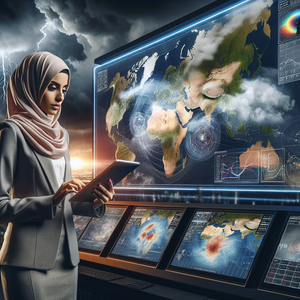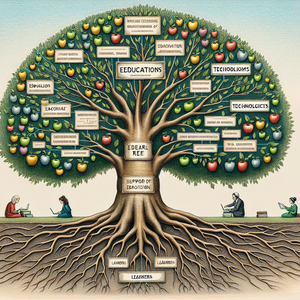The Future of Weather Forecasting: Revolutionizing Our Understanding of Weather Patterns

Artificial intelligence is at the forefront of revolutionizing weather forecasting. Traditional meteorological models often rely heavily on historical data and linear simulations, which can lead to inaccuracies, especially in rapidly changing conditions. AI, on the other hand, can process vast datasets with remarkable speed and precision, identifying complex patterns that might elude human forecasters. A prime example of this is IBM's The Weather Company, which employs AI algorithms to analyze real-time data from a variety of sources, including satellites, weather stations, and social media. By implementing deep learning techniques, their models can predict severe weather events with greater accuracy, providing critical insights that help communities prepare effectively. The ability to anticipate extreme conditions not only saves lives but also mitigates the economic impacts of natural disasters. For instance, AI-driven forecasts have proven invaluable during hurricanes, allowing for timely evacuations and resource allocation.
Satellite Advancements: A New Perspective from Above
Satellite technology has long been integral to weather forecasting, but recent advancements have significantly enhanced its capabilities. Modern satellites, equipped with high-resolution imaging and sophisticated sensors, provide an unparalleled view of atmospheric conditions. The European Space Agency's Sentinel satellites, for example, gather comprehensive data on variables such as sea surface temperatures, atmospheric composition, and even vegetation health. These advanced satellites enable meteorologists to monitor weather systems in real-time, resulting in more accurate short-term forecasts. By integrating satellite data with ground-based observations, meteorologists can achieve a more cohesive understanding of weather patterns, allowing for improved tracking of storms and other significant weather events. The imagery captured by these satellites can also be disseminated to the public, fostering a greater comprehension of weather phenomena and their potential impacts.
Crowd-Sourced Data: The Power of Community
The rise of crowd-sourced data represents one of the most innovative developments in weather forecasting. Platforms like Weather Underground empower users to share real-time weather observations from their localities, creating an extensive network of localized data points. This grassroots approach enriches the available data and offers unique insights into microclimates that traditional forecasting methods may overlook. During severe weather events, crowd-sourced data has proven particularly invaluable. For example, during Hurricane Harvey in 2017, citizens reported localized rainfall amounts, which helped meteorologists refine their predictions and issue timely warnings. This collaboration between the public and meteorologists exemplifies how community engagement can enhance forecasting accuracy, ensuring that critical information reaches those who need it most. The integration of such data not only improves immediate responses but also contributes to long-term climate studies.
The Future of Weather Forecasting: A Collaborative Effort
The future of weather forecasting will hinge on collaboration among advanced technologies, meteorologists, and the community at large. As AI continues to evolve, satellite capabilities expand, and crowd-sourced data becomes more commonplace, the reliability and accuracy of weather predictions are set to improve dramatically. This triad of innovation enhances our understanding of weather patterns and empowers individuals and communities to take proactive measures against climate challenges. Looking ahead, we can anticipate a shift toward hyper-local forecasting. Residents will gain access to personalized weather updates tailored to their specific locations and needs. This level of precision holds the potential to transform various industries, from agriculture to emergency management, ultimately fostering a more resilient society. For instance, farmers could receive forecasts that account for microclimate variations within a single field, allowing for more effective crop management.
The future of weather forecasting is illuminated by innovation and technological advancement. By harnessing the power of artificial intelligence, cutting-edge satellite technology, and crowd-sourced data, our ability to predict weather patterns is set to evolve significantly. This evolution not only enables more effective preparation for impending weather events but also equips society to confront the challenges posed by climate change. Embracing these technological advancements ensures that communities remain informed, prepared, and resilient in the face of an ever-changing atmosphere. As we stand on the brink of a new era in meteorology, the next generation of weather forecasting promises to be a transformative force in our understanding and interaction with the world around us.
Data Scientist in Meteorology
IBM, The Weather Company, National Oceanic and Atmospheric Administration (NOAA)
Core Responsibilities
Develop and implement machine learning algorithms to analyze weather data and improve forecasting models.
Collaborate with meteorologists to translate complex datasets into actionable insights for weather prediction.
Conduct statistical analyses on historical weather data to identify trends and patterns.
Required Skills
Proficiency in programming languages such as Python or R, with experience in data visualization tools (e.g., Tableau, Matplotlib).
Strong understanding of meteorological concepts and statistical methods.
Experience with AI/ML frameworks (e.g., TensorFlow, Scikit-learn).
Satellite Meteorologist
European Space Agency, NASA, National Weather Service
Core Responsibilities
Analyze satellite imagery and data to monitor atmospheric conditions and weather phenomena.
Generate and disseminate real-time forecasts based on satellite observations, enhancing short-term predictive capabilities.
Collaborate with technical teams to improve satellite data processing techniques.
Required Skills
Expertise in remote sensing and satellite technology, including experience with GIS software.
Strong analytical skills and knowledge of atmospheric science.
Familiarity with specific satellite missions (e.g., GOES, Sentinel) and their data products.
Crowd-Sourced Data Coordinator
Weather Underground, local meteorological organizations, community-driven weather initiatives
Core Responsibilities
Manage platforms for community-based weather reporting and ensure data quality and accuracy.
Analyze crowd-sourced data to identify localized weather events and trends.
Engage with the public to encourage participation and educate on the importance of weather reporting.
Required Skills
Strong communication and community engagement skills.
Experience in data management and analysis, particularly in a crowdsourcing context.
Knowledge of meteorological principles and how they apply to localized forecasting.
Climate Change Analyst
Environmental Protection Agency (EPA), research institutions, non-profit organizations focused on climate change
Core Responsibilities
Research and analyze the impacts of climate change on weather patterns and forecasting accuracy.
Collaborate with meteorologists to integrate climate data into forecasting models and community planning.
Prepare reports and presentations to communicate findings to stakeholders.
Required Skills
Strong background in climate science, environmental policy, or related fields.
Proficiency in statistical software and data analysis tools.
Excellent written and verbal communication skills for report writing and public presentations.
Meteorological Software Developer
Meteorological software companies, government meteorological agencies, and tech companies focused on weather data solutions
Core Responsibilities
Design and develop software tools and applications for weather forecasting models.
Collaborate with meteorologists to understand user needs and improve software functionality.
Conduct testing and maintenance of forecasting software to ensure accuracy and reliability.
Required Skills
Proficiency in programming languages such as Java, C++, or Python, with a focus on software development lifecycle.
Understanding of meteorological modeling and data processing techniques.
Experience with cloud computing platforms and big data technologies.


